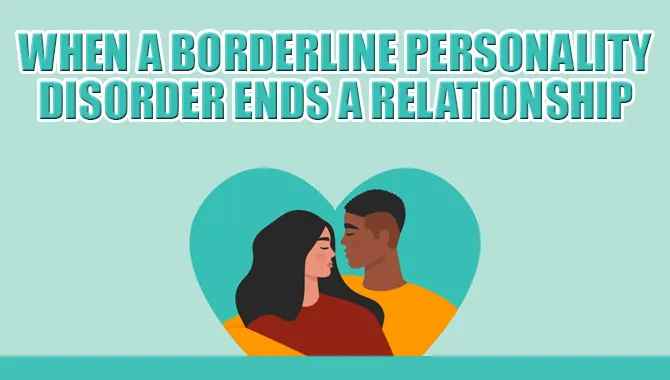A borderline personality disorder is a grossly overused condition. It’s past time to make a difference. Borderline personality disorder (BPD) is a character condition that affects how people think and believe in themselves and everyone else. It is also referred to as schizoid personality disorder.
So, how long does BPD idealization last? Powerful feelings of abandonment characterize borderline personality disorder (BPD), difficulty maintaining meaningful relationships, powerful emotions, poor impulse control, and sometimes even psychosis or detachment.
This can be a frightening disease to deal with experiencing, hence why individuals with BPD need to be accompanied by experts who recognize but also encourage themselves. Let us highlight some symptoms of this disease.

1. Anything Is Much More Deeply Experienced
BPD can be powerful, as though we’re waffling among two extreme values. Both we those around us may become exhausted as a result of all this. Although it’s vital to realize that whatever the individual with BPD believes at the moment is wholly acceptable in their perspective.
So don’t inform us that we’re acting stupid and make us feel like the emotions are not real. This could take people some while to ponder on our views, although events may seem terrifying in the meantime. It entails not passing judgment and, when necessary, providing time or space.
2. It Is Indeed Draining Plus Aggravating
Most individuals with BPD go undiagnosed, and it’s not because people don’t want to be helped. That’s because this medical disorder is really not addressed the same way other mental disorders are.
For one thing, BPD is really not prescribed for the treatment. Only psychotherapy, including dialectical behavioural therapy (DBT) as well as cognitive-behavioural therapy (CBT), can help (CBT).
There have been no medicines that have been known to be successful in the treatment of BPD. It is indeed accurate how some professionals think persons with BPD would be hard clients because of the stigma, making finding successful therapy challenging.
Comprehensive DBT courses may help so many people having BPD, and they’re not always easy to find.
3. We Are Really Not Incapable of Love, Yet We Enjoy Huge Things

BPD patients have such a soft heart, to the point in which it can be overpowering. Partnerships can become a frenzy in moments when somebody with BPD, particularly those who are dealing with persistent feelings of sadness and loneliness, establishes a true connection, and the euphoria could be as high as any other feeling.
This could make it tough to be in connection with somebody who has BPD, but that also indicates that this would be an individual who has a soft heart.
People genuinely want to know whether their emotions are reciprocated and that they might require additional reassurance to guarantee that now the connection remains gratifying for both of you.
4. We’re Terrified You Will Leave

Probably the greatest manifestation of BPD is the dread of deserting, and this can happen in any event when things in the relationship appear to be going well.
There’s this unavoidable dread that individuals will leave us or that we aren’t adequate for that individual, and regardless of whether it appears to be silly to other people, it can feel genuine to the individual who’s struggling.
Someone with BPD would successfully prevent that from occurring, which is the reason they might seem to be being “tenacious” or “penniless.” Though it tends to be hard to understand, recollect that it originates from a position of dread, which can be staggeringly difficult to live with.
5. I Don’t Have Different Characters

Because it is a behavioural condition, BPD is regularly mistaken for somebody having a dissociative character problem, where individuals foster different personalities. But this isn’t true by any stretch of the imagination. Individuals with BPD don’t have more than one character.
BPD is a behavioural condition wherein you experience issues with how you think and feel about yourself and others and are having issues in your day to day existence subsequently.
That doesn’t imply that dissociative personality problems ought to be derided, either, yet it surely shouldn’t be mistaken for another issue.
6. It Seems Like Carrying on With an Existence With Third-degree Enthusiastic Consumes
This individual says it is spot on individuals with BPD have extremely exceptional feelings that can endure from a couple of hours to even a couple of days and can change very quickly. We can go from feeling exceptionally glad to abruptly feeling exceptionally low and dismal.
Some of the time, having BPD resembles treading lightly for yourself. We never know what direction our state of mind is heading to go, and at times it’s difficult to control.
7. Borderline Personality Disorder Condition Is Regularly Misjudged

Borderline personality disorder condition, now and again known as a touchy behavioural condition, is a behavioural condition that influences how you think and feels about yourself and other people.
Individuals with Borderline personality disorder (BPD) frequently have a solid dread of surrender, the battle to keep up with sound connections, have extremely exceptional feelings, act imprudently, and may even experience suspicion and separation.
It very well may be a startling disease to live with, which is the reason it’s entirely significant, to the point that individuals with BPD are encircled by individuals who can comprehend and uphold them. But at the same time, it’s an amazingly vilified sickness.
Due to a plentiful confusion around it, many individuals with the issue feel frightened to take a stand in opposition to living with it. Yet, we need to change that.
That is the reason I connected and requested that individuals with BPD let us know what they need others to know about living with the condition.
Borderline personality disorder (BPD) has generally been viewed as a deep-rooted, exceptionally incapacitating problem. Examination during the beyond twenty years has tested this supposition.
It is composing surveys the course of BPD all through life, including youth, immaturity, and adulthood.
BPD can be precisely recognized in immaturity, and the course of the issue, in youth and adulthood, is by and large comparable, with decreases in manifestations over the long run.
Utilitarian recuperation is less reliable, and further exploration on elements or medicines that might work on the drawn-out useful result of patients with BPD is justified.
How Long It Lasts and Remedy

Sufferers with BPD are as regularly as feasible located in a wide range of scientific settings. They represent 10% of outpatients,20% of inpatients, and six% of sufferers added to the circle of relatives medicinal drug.
However, a local location predominance of one% to 2%. four regionally, there may be an equal sexual orientation proportion, notwithstanding girls being seen three to more than one instances all the more habitually in medical settings.
If they are not visible as a thing of a drawn-out complies with-up or a treatment program, they may be typically seen in an emergency.
This has given numerous the feeling that sufferers with BPD are always in emergency and by no means recover from their sickness, prompting this amassing of patients to be profoundly derided within the emotional well being care device.
Sufferers with BPD do bear severely. However, their forecast is often distinctly true, and the results are moreover advanced with the appropriate remedy.
Like any PDs, BPD necessitates that sufferers experience issues that can be inescapable, inflexible, disabling, and out of doors the usual for his or her social foundation.
DSM-five likewise suggests that the instance of conduct starts off evolved in immaturity or early adulthood, if not earlier. DSM-five, as DSM-IV, licenses diagnosing a PD in anyone below 18 years antique if the manifestations are unavoidable.
Tenacious, and in all likelihood no longer going to be confined to a specific formative level or one extra mental trouble as long as indications had been available for three hundred and sixty-five days or longer.
This composing will portray the longitudinal path of BPD in all age gatherings, emphasizing the utilitarian and suggestive consequences of those patients.
Information on the route of BPD can have a sizable effect on the medical management of sufferers with the disorder. One of the first issues is as it should be diagnosing the ailment.
As previously mentioned, BPD can frequently be recognized in children and teenagers, and it’s far at this age that clinicians need to start to search for signs and symptoms of the disorder.
The course of the ailment seems unstable all through childhood, but the long-time period route for most sufferers is essentially identical to what is seen in adults.
As evidence-based totally treatments are available, even though proof in youngsters isn’t always as strong as it’s miles in adults, patients have to be directed to those psychotherapies as early as feasible.
There is no intent to wait to provide prognosis and remedy, and the various arguments for ready aren’t primarily based on evidence.
Subsequently, supplying a correct diagnosis and imparting statistics on the normally positive effects for BPD can instill wish in sufferers who, all too frequently, feeling completely hopeless.
Proof shows that even a single consultation of psychoeducation approximately the analysis can be useful. One of the all-too-common motives to avoid BPD prognosis in all age groups is the worry of stigmatization.
BPD is thought to be incredibly stigmatized in intellectual health settings, mainly in youth mental fitness, and part of the motive for the stigma is that BPD is visible as a lifelong sickness this is untreatable.
Truly, patients with BPD may be cautiously constructive about their analysis, and lots of remedies exist that may profoundly enhance their lives.
Tons of the stigma takes place when clinicians come across those sufferers in crisis settings, together with the emergency department, crisis clinics, and well known psychiatric inpatient wards.
As those are not the settings in which treatment takes place, clinicians broaden a biased angle on these sufferers.
Few clinicians could have the possibility to see those patients improve through the years in specialized remedy clinics; nonetheless, those sufferers improve and are treatable.
Awareness of the direction of BPD is one effective manner of decreasing stigma in opposition to the prognosis. Despite the fact that the route of BPD is normally high-quality, a few patients do enjoy relapses over the years.
Most of the specialized remedies for BPD are time-restricted and normally of 1 to a few years in length. This makes them luxurious, and a few professionals propose that a higher model of care for patients with BPD could be intermittent psychotherapy.
The intermittent remedy might also permit sufferers to address different troubles at one of a kind factors of their lives. For example, DBT focuses basically on self-damage and suicidality, which have a tendency to be problems early on within the lives of patients with BPD.
As those signs remit with time, patients who are older can also want to address issues relating to emptiness and fear of abandonment, which aren’t without delay addressed by means of DBT and are symptoms that are slower to remit.
An intermittent psychotherapy model could permit sufferers to pay attention to unique problems at unique instances in their lives, the use of the therapeutic approach that has the quality evidence for that hassle.
A related issue is the negative lengthy-term practical reputation of patients with BPD. Zanarini et al. validated that recovery is substantially much less probable in sufferers with BPD than in an Axis II assessment organization.
Slightly more than one-1/2 the sufferers with BPD achieved recuperation, which was described as remission from signs in addition to good, full-time vocational or academic functioning and as a minimum one strong and supportive dating with a friend or companion.
Patients with BPD had also been quite probably to swiftly lose their healing. Several factors have been diagnosed as predictors of healing, together with now not being hospitalized, higher IQ, earlier suitable vocational functioning, absence of a cluster C comorbidity, and the trait measures of excessive extraversion and excessive agreeableness.
Restoration becomes additionally associated with both marriages and being a determine, although often at an older age than non recovered sufferers. Another longitudinal examination confirmed that the worldwide evaluation of Functioning scores changed into a decrease within the BPD organization.
A substantially fewer of these patients finished levels that represented desirable functioning and were also much more likely to get hold of social assistance.
As purposeful recovery is so hard for sufferers with BPD to acquire and hold, this will become a vital lengthy-term goal for intervention.
Presently, the handiest long-term examination to determine vocational or academic functioning without delay indicates that mentalization-primarily based treatment, furnished in an 18-month partial hospitalization setting, is associated with a more threat of being hired or in faculty up to 8 years later.
Different studies have additionally proven progressed social and international functioning. However, those had been now not number one outcomes and had been no longer significantly special among the exclusive treatments; also, the length of follow-up changed into too brief.
Thus there’s evidence that, while remedy is probably to result in upgrades in practical healing, there may be an extremely goodabsence of research that focus on this as a primary outcome.
Attention ought to take delivery of to offering sufferers with BPD as tons assist in attaining functional recuperation as possible.
This will encompass psychosocial programs aimed toward returning to paintings and evaluation and involvement from occupational therapists, vocational counsellors, or different experts who can help patients develop the competencies vital for any form of work.
Conclusion
I hope now you know how long does BPD idealization last.
Borderline personality disorder (BPD) is a mental disorder characterized by intense and unstable relationships, intense and unstable emotions, and difficulties with self-image and self-identity.
While the symptoms of BPD can fluctuate over time, the disorder typically lasts for a lifetime. To understand the symptoms of BPD and how they may change over time, it is important to know the symptoms of BPD idealization and devaluation.
FAQs
1. How Can I Help My Partner Recognize And Overcome Their BPD Idealization?
Talking and communicating with your partner about their thoughts and feelings towards you is important. If you notice that they constantly idealize you, it may be time to seek professional help.
However, one of the earliest signs that your partner may harbor BPD Idealization is if they constantly idealize you. If you constantly think about how you can make your partner better, it may be a sign that they are not treating you fairly.
It’s important to remember that no one is perfect, and everyone has flaws. Together, we can work on addressing these issues so our relationship remains healthy.
2. What Are Some Signs That My Partner May Be BPD Idealized?
Some signs that your partner may have BPD are typical. If they find it difficult to see any faults in you. And view everything that comes your way as a challenge or opportunity for growth and development.
If this is happening, it might be worth trying to talk to them about what’s happening and see if there’s a way to work through the disorder.
3. Is It Possible To Fix A Relationship That Is Entrenched In BPD Idealization?
It is possible to fix an entrenched relationship with BPD Idealization, but it is difficult. Some things that may help include: being understanding and nonjudgmental, creating calm environments, setting boundaries, etc. However, the person with BPD may be in shock or disbelief, so patience and understanding are crucial.
4. Can Unilateral Relationships Survive Experiencing Deep Romantic Love For Each Other?
There is no single answer for this question as it depends on the individual. And their relationship with their borderline personality disorder (BPD) partner. However, some things that may be helpful for both partners include:
– Communicating openly and honestly about what is going on in the relationship.
– Respecting each other’s needs and boundaries and working towards mutually agreed upon goals.
– Fighting fair and treating one another with kindness and consideration. – Recognizing that relationships with BPD individuals may frequently experience highs and lows, they will ultimately survive based on the level of communication and compromise between the two parties.
5. How Can I Tell If I’m In A BPD Stage?
There are many signs that you might be in a BPD stage, but idealization typically refers to the phase where someone falls in love with their partner/partner of choice, despite all the red flags. During this phase, individuals can become fixated on their partner, start questioning reality and lose touch with their own emotions.
If you’re finding it hard to let go of your partner and are constantly justifying their behavior, then you might be in a BPD stage.
However, there’s no one-size-fits-all answer to this question, as everyone goes through different stages of BPD at different points in their lives. So if you’re not sure whether or not you’re in a BPD stage. It’s best to consult with a mental health professional.






